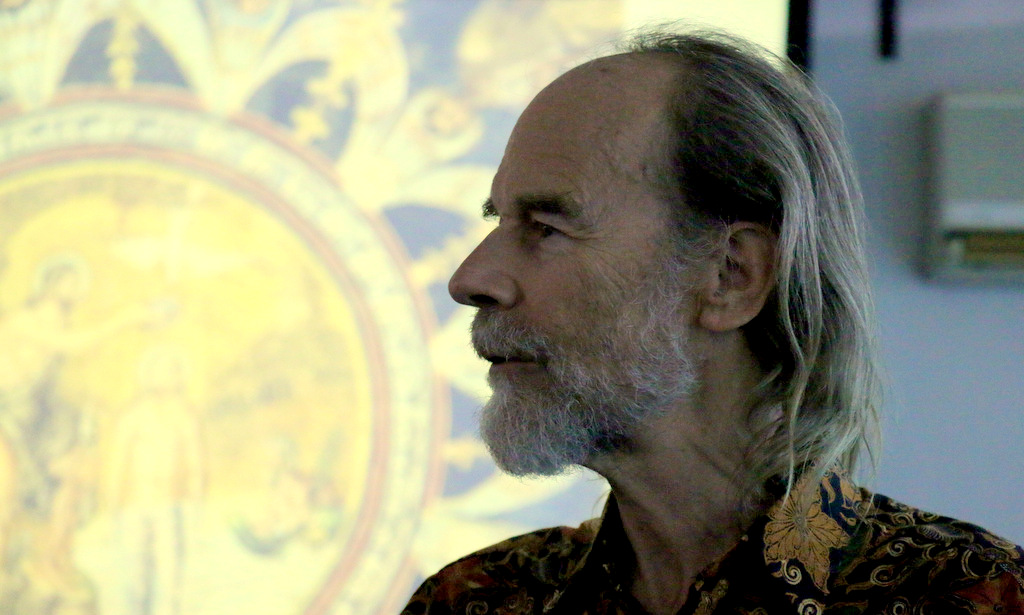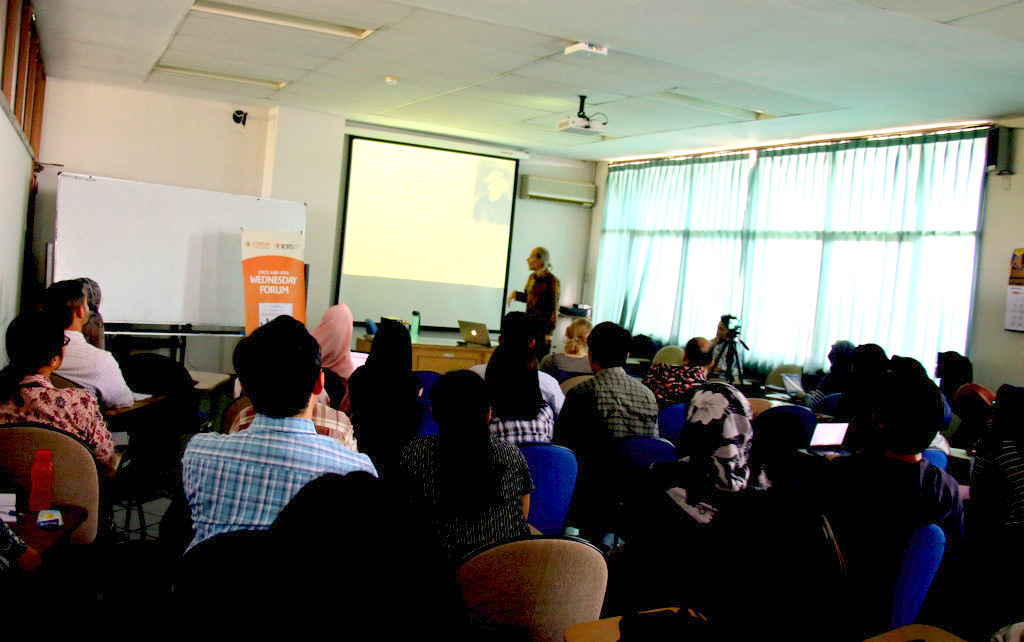
Co-creatureliness as a narrative of ethics in the Anthropocene
Harriet Crisp – 13 September 2019
Creeping its way into every day discourse is the Anthropocene, a new geological epoch in which humans have been the dominant influence on the Earth’s environment and climate, unfortunately with unsustainable activities and damaging effects. As these effects become increasingly visible in our modern world, the question remains how we as a worldwide community can stop, or perhaps even reverse, the effects of global warming.
Looking at the current crisis, the historical background of the Anthropocene, and religious examples of human/nature interactions, Michael Northcott, professor of religion and ecology at the Indonesian Consortium of Religious Studies, introduces the concept of ‘creaturely ethics’, an inclusive new framework for dealing with the current ecological crisis, at the CRCS-ICRS Wednesday Forum, 28th August 2019.
The Anthropocene epoch, popularised by Nobel Prize-winning chemist Paul Crutzen in 2000, reflects the imbalance in the world caused by humanity’s movement of materials and changing of chemicals in the earth and atmosphere. There are two distinctive moments in history which are thought to mark the beginning of the Anthropocene. For Crutzen, the beginning of the epoch can be traced to the latter half of the 18th century and James Watt’s invention of the steam engine. Northcott explained how it was during this period which saw the beginning of increased production of manmade greenhouse emissions, primarily C02, CH4 and N20. Northcott himself however points to much later during the 1950s. This was period known as ‘the Great Acceleration’ due to the rapid increase in human population, energy and water use, technological advancement, consumerism, and tourism, among other things.
Using graphs displaying human activity over the past fifty years (see below in slides by IGBP and notice what the year 1950 marks), Northcott emphasised just how rapid technology and industry has developed, and how this development has directly correlated with rising global emissions, deforestation, extinction and other crises. In the past fifty years 70% of all land areas are now managed by humans, 90% of all fish in the oceans have been harvested since 1950, and there is currently 50 kg of ‘waste’ per square metre of planet. Quoting Will Steffen, “In a single lifetime humanity has become a planetary-scale geological force” (in Anthropocene Review, 2015).
[slideshare id=43547922&doc=greatacceleration2015-150115075518-conversion-gate02]
Humans’ embeddeddness into Earth system
Northcott introduced James Hutton, the 18th century geologist who created the concept of the Earth System by studying patterns of geomorphic and sedimentary rock found in his native Scotland to try and understand the timescale and processes necessary to produce such features. Looking at the layers of up-thrusted rock formations and patterns in erosion, Hutton concluded that the Earth was potentially billions of years old, far older than the history of humanity. If we view the Earth’s history as a 24-hour clock for example, the whole of human history can be packed into less than a minute.
This narrative of insignificance is common within modern science, countering ideas of anthropocentrism from earlier theological beliefs. But, Northcott reasons, this idea should be reviewed. If Hutton’s Earth system was all about ‘the interrelation of geophysical, chemical and biological processes’ – a symbiotic relationship between the land, oceans, atmospheres and poles – now human activity is ‘embedded’ into this system. There are no elements left untouched by human hands. Our species now shapes the planet, and for Northcott it is the religious thinkers who have been saying this all along.
The Genesis story is an obvious example of a religious narrative about the responsibility of humans on the planet. But Northcott points to modern history, as far back as the 1800s, where theologians grappled with the profound impact humans have on the climate. Antonio Stoppani in Corso Geologgia (1873) termed human’s impression on the Earth as the ‘Anthropozoic Era’, marvelling at the power wielded by mankind. John Ruskins, the artist and writer lamented the manmade fogs that hung over Manchester and called for humanity to act humbly and with restraint, to return to God.
Northcott also introduced Pierre Teilhard de Chardin who explored how the boundaries of the world and humankind are blurring more so than ever in a “gigantic planetary contraction” (in Heart of Matter, 1948). Northcott used an example of driving to Bali: You set the intention of driving from Yogyakarta to Bali, in acting on this intention, you use of fuel which in turn produces C02 emissions. The very intention of getting to Bali via the means of a fossil fuel powered vehicle have added to the atmosphere and thus changed the planet. Each decision made in the brain is intrinsically linked to the Earth’s climate and processes.

Developing a co-creaturely ethics
So what is a possible solution? Crutzen suggests the potential of a world governance, who manage the “wise use of Earth’s resources, control of human and domestic animal population, and overall careful manipulation and restoration of the natural environment” (in Earth System Science in the Anthropocene, 2006).
Yet for Northcott, the concept of a transnational controlling body is implausible, particularly when considering the rise of populist governments across the planet and the increasing power of multinational corporations like Google and Amazon. Pope Francis, in his encyclical Laudato Si (2015), points to the maelstrom of economic growth without limits, the destruction of the environments and livelihoods of the poor, blind following of the ‘magic of markets’, and technological power as the “root causes of the ecological crisis”. He believes we must move away from the carbon economy and into a circular one in order to slow the process. But control and regulation is not enough. There needs to be a shift in the growth-above-all mindset and development of ethics in relation to the ecological crisis.
Northcott returns to the theologians and their emphasis on ‘community, compassion and care’. Taking the parable of the good Samaritan from the New Testament, Northcott explained how in the current crisis, we should act like the Samaritan, helping those who are foreign to us, and “who are affected by our actions at a distance” by engaging in the global community. Using a variety of examples from across religious traditions, creatures, Northcott explained, “are implicated in our salvation, and in our move from Earth to Heaven.” They “are also beings with purposes which ought to be respected.” It is this which Northcott terms as ‘the co-creatureliness’.
Co-creatureliness ethics has two main purposes. The first is the development of the idea that humans cannot save the environment single-handedly, but instead must provide the spaces for nature to return and replenish as it once was – a practice commonly referred to as ‘rewilding’. The second aim is to develop a new, religiously minded narrative allowing communities to understand the issues of global warming, and the steps that need to be made, without being faced with cold facts and statistics.
The concept of rewilding and allowing nature to manage environments can link with previous ideas of stewardship and God’s vicegerency found within Abrahamic religions, as we can’t escape the sense of responsibility about what has happened to the planet, we can help provide spaces for other creatures to manage. Northcott pointed to the example of Knepp Castle Estate in the UK. The owner Charlie Burrell was failing to make profit through modern agriculture, deciding to use the space instead to allow rewilding. By leaving the natural shrubs and thorn bushes to grow, new trees could seed in amongst the brambles, this was the first step. Next he brought in one of the oldest forms of cattle, as well as other animals, who naturally managed the land. Bird and plant species in the area as a result have greatly increased.
Northcott also introduced a similar case in Papua, where an area with vast shark and fish depletion was restricted for human access. In doing so, the shark population jumped back with incredible speed and the coral and fish populations have also made a recovery, a representation of the interconnected nature of an ecosystem. Cases like this have proved far more effective than special scientific zones, or national parks, which are managed by humans.
The second aim of co-creaturely ethics is the more slippery task of developing an effective narrative. Co-creaturely ethics forms a symbiotic explanation of science, culture and religious tradition, allowing a new environmental form of religious ethics. It is down to those who can take the information presented by science, and develop it into a narrative that moves. As Michael Northcott finished his presentation, “Straight scientific facts do not change behaviour. You have to mediate the science through culture.”
________________
The writer, Harriet Crisp, is a CRCS student of the 2019 batch.
Read also another Wednesday Forum report on the same topic: Developing an “ecological conversion” within world religions
Look at Anthropocene timeline here.

